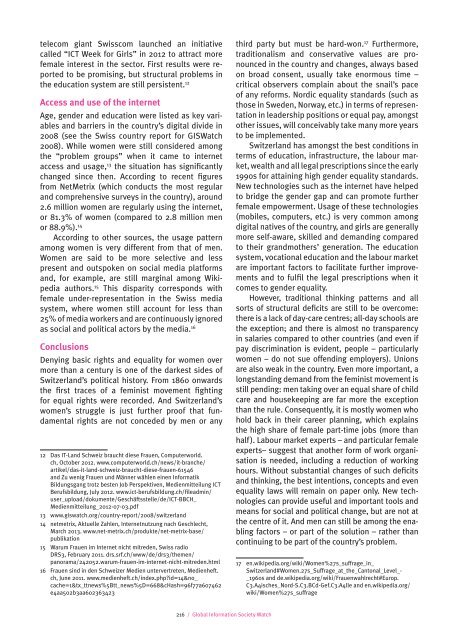gisw13_chapters
gisw13_chapters
gisw13_chapters
Create successful ePaper yourself
Turn your PDF publications into a flip-book with our unique Google optimized e-Paper software.
telecom giant Swisscom launched an initiativecalled “ICT Week for Girls” in 2012 to attract morefemale interest in the sector. First results were reportedto be promising, but structural problems inthe education system are still persistent. 12Access and use of the internetAge, gender and education were listed as key variablesand barriers in the country’s digital divide in2008 (see the Swiss country report for GISWatch2008). While women were still considered amongthe “problem groups” when it came to internetaccess and usage, 13 the situation has significantlychanged since then. According to recent figuresfrom NetMetrix (which conducts the most regularand comprehensive surveys in the country), around2.6 million women are regularly using the internet,or 81.3% of women (compared to 2.8 million menor 88.9%). 14According to other sources, the usage patternamong women is very different from that of men.Women are said to be more selective and lesspresent and outspoken on social media platformsand, for example, are still marginal among Wikipediaauthors. 15 This disparity corresponds withfemale under-representation in the Swiss mediasystem, where women still account for less than25% of media workers and are continuously ignoredas social and political actors by the media. 16ConclusionsDenying basic rights and equality for women overmore than a century is one of the darkest sides ofSwitzerland’s political history. From 1860 onwardsthe first traces of a feminist movement fightingfor equal rights were recorded. And Switzerland’swomen’s struggle is just further proof that fundamentalrights are not conceded by men or any12 Das IT-Land Schweiz braucht diese Frauen, Computerworld.ch, October 2012. www.computerworld.ch/news/it-branche/artikel/das-it-land-schweiz-braucht-diese-frauen-61546and Zu wenig Frauen und Männer wählen einen InformatikBildungsgang trotz besten Job Perspektiven, Medienmitteilung ICTBerufsbildung, July 2012. www.ict-berufsbildung.ch/fileadmin/user_upload/dokumente/Geschäftsstelle/de/ICT-BBCH_Medienmitteilung_2012-07-03.pdf13 www.giswatch.org/country-report/2008/switzerland14 netmetrix, Aktuelle Zahlen, Internetnutzung nach Geschlecht,March 2013. www.net-metrix.ch/produkte/net-metrix-base/publikation15 Warum Frauen im Internet nicht mitreden, Swiss radioDRS3, February 2011. drs.srf.ch/www/de/drs3/themen/panorama/242052.warum-frauen-im-internet-nicht-mitreden.html16 Frauen sind in den Schweizer Medien untervertreten, Medienheft.ch, June 2011. www.medienheft.ch/index.php?id=14&no_cache=1&tx_ttnews%5Btt_news%5D=668&cHash=96f77a607462e4aa502b3aa602363423third party but must be hard-won. 17 Furthermore,traditionalism and conservative values are pronouncedin the country and changes, always basedon broad consent, usually take enormous time –critical observers complain about the snail’s paceof any reforms. Nordic equality standards (such asthose in Sweden, Norway, etc.) in terms of representationin leadership positions or equal pay, amongstother issues, will conceivably take many more yearsto be implemented.Switzerland has amongst the best conditions interms of education, infrastructure, the labour market,wealth and all legal prescriptions since the early1990s for attaining high gender equality standards.New technologies such as the internet have helpedto bridge the gender gap and can promote furtherfemale empowerment. Usage of these technologies(mobiles, computers, etc.) is very common amongdigital natives of the country, and girls are generallymore self-aware, skilled and demanding comparedto their grandmothers’ generation. The educationsystem, vocational education and the labour marketare important factors to facilitate further improvementsand to fulfil the legal prescriptions when itcomes to gender equality.However, traditional thinking patterns and allsorts of structural deficits are still to be overcome:there is a lack of day-care centres; all-day schools arethe exception; and there is almost no transparencyin salaries compared to other countries (and even ifpay discrimination is evident, people – particularlywomen – do not sue offending employers). Unionsare also weak in the country. Even more important, alongstanding demand from the feminist movement isstill pending: men taking over an equal share of childcare and housekeeping are far more the exceptionthan the rule. Consequently, it is mostly women whohold back in their career planning, which explainsthe high share of female part-time jobs (more thanhalf). Labour market experts – and particular femaleexperts– suggest that another form of work organisationis needed, including a reduction of workinghours. Without substantial changes of such deficitsand thinking, the best intentions, concepts and evenequality laws will remain on paper only. New technologiescan provide useful and important tools andmeans for social and political change, but are not atthe centre of it. And men can still be among the enablingfactors – or part of the solution – rather thancontinuing to be part of the country’s problem.17 en.wikipedia.org/wiki/Women%27s_suffrage_in_Switzerland#Women.27s_Suffrage_at_the_Cantonal_Level_-_1960s and de.wikipedia.org/wiki/Frauenwahlrecht#Europ.C3.A4isches_Nord-S.C3.BCd-Gef.C3.A4lle and en.wikipedia.org/wiki/Women%27s_suffrage216 / Global Information Society Watch


